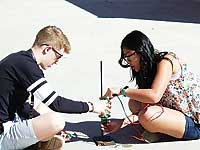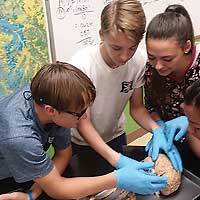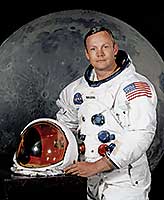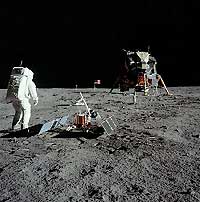|
|
Science HAPPENINGS July 2019 |
Remember when science was fun?
by Laura Reed |
 |
| Trying to fix the launching apparatus - a never ending problem in chemistry class during bottle rocket week. |
I can’t tell you how often I poured vinegar into baking soda and delighted in watching it bubble up – hoping the kitchen ware I chose would contain the “explosion.” I’m sure we all have examples of playing with science when we were kids: making bubbles, tormenting insects with a magnifying glass, collecting shells on the beach, finding the prettiest rock, mixing up the food coloring hoping to discover a new color for cake frosting. And then there was a day in school when it all just got hard. The teacher didn’t just want me to have fun, the teacher wanted me to know: how could I make bigger bubbles; why does a magnifying glass intensify the sunlight; how did the shell get on the beach; what are the grains and minerals in the rock and how’d they get there; why did I always end up with brown frosting? Why is figuring things out so hard?
Yep the science got hard. Actually, a better word might be challenging. The science got challenging – (and so did the math and statistics.) I remember being in classes trying to figure out equilibrium constants or orbital hybridization; genetic recombination frequencies or the size of a bacterium on a microscope slide. I sometimes (and still do) really hate it, but instead of throwing the book done and escaping into internet distraction, I pick up the pencil and paper and get back to trying to figure out something that I didn’t know. Why keep going? Why do those of us who love science keep doing it if it is so hard and brain-tiring? Because we know there will be a moment when we do know. When the time and energy put forth brings about the joy of having figured something out. So much more fun than the internet memes and YouTube videos that I had easily distracted me from the time and hard work that was needed to go into the problems.
 |
| Students examining a brain during a USU lab class |
And boy do we have problems. As humans have always had. So many of these (health care, pollution and waste, climate, energy, farming and crop management. . .) might and will probably have scientific and technological solutions that will require a growing need for a highly educated, scientifically and mathematically literate population. The young minds we have in our schools today will be part of this population of problem solvers that need to know that although it is fun to watch baking soda volcanoes explode, science and math are hard, and when they walk into their classrooms they should not expect something easy. They should hope that their teachers are aware of the world’s needs and that they will be challenged - and sometimes fail. In that failure comes discovery, motivation to push onward, and then eventually if you don’t give up - success. And relief and happiness and laughter and joy and what the late physicist Richard Feynman called the “pleasure of finding things out.” It’s the hard work and challenge that makes science fun. So when the students ask me at the beginning of class - as they often do - “Are we going to have fun today?” I always reply, “Yes, we are going to have fun.” What they soon find out is that it’s not the fun they thought it was going to be. It is something so much better.
|
50th Anniversary of the First Moon Landing
by Spencer Stokes |
 “One small step for man… One giant leap for mankind”. Few statements carry the weight behind them as the words uttered by Neil Armstrong on July 20th, 1969. Neil had just become the first person to step on the surface of the moon. The success of the moon landing represents one of the pinnacles of mankind’s achievements. To travel hundreds of thousands of miles through the void of space, land on another celestial body, and then return to earth was unimaginable for most of history. “One small step for man… One giant leap for mankind”. Few statements carry the weight behind them as the words uttered by Neil Armstrong on July 20th, 1969. Neil had just become the first person to step on the surface of the moon. The success of the moon landing represents one of the pinnacles of mankind’s achievements. To travel hundreds of thousands of miles through the void of space, land on another celestial body, and then return to earth was unimaginable for most of history.
The goal of reaching the moon was given by President John F. Kennedy in 1960. His words acted as a guide for the rest of the decade and they read as follows, “We choose to go to the Moon! We choose to go to the Moon...We choose to go to the Moon in this decade and do the other things, not because they are easy, but because they are hard; because that goal will serve to organize and measure the best of our energies and skills, because that challenge is one that we are willing to accept, one we are unwilling to postpone, and one we intend to win, and the others, too.” The program responsible for getting men to the moon was the Apollo program, and it was fraught with difficulties. The first crew of Apollo 1, were met with tragedy. A fire broke out in the test module on February 21, 1967 and killed the three astronauts aboard. Their names were “Gus” Grissom, Ed White, and Roger B. Chaffee. They were the only astronauts to be lost in the Apollo program. Twenty months after the accident manned test flights recontinued, and on July 20th, 1969, the program came to fruition with the first moon landing.
Dead Horse Point State Park is celebrating the 50th anniversary of the first moon landing on July 20th, 2019. The celebration details are not yet complete so check our website and facebook for updates. Plan to enjoy a presentation and moon astronomy underneath our dark skies. We will be using telescopes to view the landing site of Apollo 11 and other features of the moon. Join us so we can remember the momentous achievement of putting a man on the moon.
Dead Horse Point State Park is located nine miles north of Moab on US 191 and 23 miles south on SR 313. The visitor center and Bighorn Gallery are open daily from 9am-5pm. Park admission is $20 per vehicle for three days. For more information, please contact the park at 435-259-2614. |
|
|
|
|
|
© 2002-2024 Moab Happenings. All rights
reserved.
Reproduction of information contained in this site is
expressly prohibited.
|
|


 “One small step for man… One giant leap for mankind”. Few statements carry the weight behind them as the words uttered by Neil Armstrong on July 20th, 1969. Neil had just become the first person to step on the surface of the moon. The success of the moon landing represents one of the pinnacles of mankind’s achievements. To travel hundreds of thousands of miles through the void of space, land on another celestial body, and then return to earth was unimaginable for most of history.
“One small step for man… One giant leap for mankind”. Few statements carry the weight behind them as the words uttered by Neil Armstrong on July 20th, 1969. Neil had just become the first person to step on the surface of the moon. The success of the moon landing represents one of the pinnacles of mankind’s achievements. To travel hundreds of thousands of miles through the void of space, land on another celestial body, and then return to earth was unimaginable for most of history.